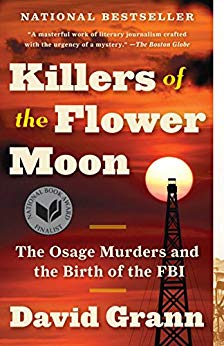

This article is an excerpt from the Shortform summary of "Killers of the Flower Moon" by David Grann. Shortform has the world's best summaries of books you should be reading.
Like this article? Sign up for a free trial here .
Who was Martha Vaughan? What’s her role in Killers of the Flower Moon?
Though Martha Vaughan was not alive during the Osage Reign of Terror, she helped author David Grann gain perspective on the events and cases. Vaughan pointed out that the Osage Reign of Terror was even bigger than the events Grann wrote about in the book.
Read more to learn about Martha Vaughan and the difference she made.
Martha Vaughan on the Osage Murders
Although the Reign of Terror took place nearly a century ago, its memory haunts the Osage today. A great-grandson of the slaughtered Henry Roan told David Grann, author of Killers of the Flower Moon, that the murders are always in the back of his mind, especially knowing how personally connected he was to all of it. Martha Vaughan ultimately would be a major source for Grann.
In his archival research and interviews with descendants of victims of the Reign of Terror, Grann made a shocking discovery—Hale and his gang were not the sole perpetrators of the murderous conspiracy. Although the Bureau had declared the case to be closed when Hale, Burkhart, Morrison, and Ramsey were convicted, many more people had taken part in the slaughter. Not all of the murders could be linked to Hale—and justice had never been done for these victims.
The Osage with whom the author spoke told him that there were many unsolved murders from the Reign of Terror that were never counted among the totals and never properly investigated by the Bureau. As he pored over the archival record, Grann discovered the stories of Osage who had been murdered before the Reign of Terror’s conventional start date of 1921. One Osage woman, Mary Lewis, had been bludgeoned to death with a hammer by two white men, and her body was left to rot in a swamp. This heinous crime had occurred in 1918, three years before Anna Brown was found in the ravine. The Burkhart-Hale saga may have been the bloodiest episode of the Reign of Terror, but it was just one thread in a vast web of murder and mayhem.
Grann made contact with Martha Vaughan, a granddaughter of W. W. Vaughan, the attorney and confidante of George Bigheart who had been mysteriously strangled and thrown from a train after he’d publicly declared his intention to intervene on behalf of the Osage in 1923. Vaughan had been Bigheart’s attorney and was helping him obtain a certificate of competence, which would have entitled Bigheart to freely spend his headright money instead of having it frozen in a guardianship. Yet a few days after Bigheart had conferred with Vaughan, both men were dead.
Martha Vaughan believed that there was more to the murder than Hale simply wanting to eliminate someone he perceived as a threat. She said that a relative who had tried to investigate Vaughan’s death after Hale’s incarceration had received an anonymous letter threatening to kill the entire family if he looked into the matter any further. Whatever the conspiracy was, it went beyond Hale.
Martha Vaughan also revealed that a shadowy and unscrupulous figure named H. G. Burt had embezzled Vaughan’s estate after his death. When Grann dug further, he discovered that Burt had been deeply involved in the “Indian business,” borrowing money on the cheap from whites before loaning it back out to Osage at usurious interest rates. In reality, he was little more than a loan shark. Agents of the Bureau had identified Burt as an associate of Hale during the original investigation, but never brought charges against him.
As it turned out, Burt had been named guardian of Bigheart’s daughter’s headright (as he had been for many other Osage) and would have been in a position to greatly profit from Bigheart’s death. Moreover, a news article at the time of Vaughan’s murder from the Pawhuska Daily Capital revealed that Burt had been a passenger on the very same train from which Vaughan was thrown. It may have been circumstantial, but the evidence in the historical record of Burt’s guilt was overwhelming—and he was merely one of the countless white Oklahomans of the time who stood to gain handsomely from the bloody “Indian business.”
The True Toll
The archival records showed a seemingly endless series of Osage wards who died under mysterious circumstances during this era. Because these cases were never investigated by local authorities, private investigators, or even the Bureau of Investigation, it was impossible to determine conclusively whether or not these individuals had been murdered. But their frequency and shared characteristics strongly hinted at a conspiracy, just like Martha Vaughan believes.
Many deaths that looked innocuous were anything but. One Bureau agent wrote in the case files that white perpetrators would get an Osage drunk and take them to a doctor (like the Shoun brothers) who would declare them intoxicated. Poison would then be injected into the victim, after which the doctor would pronounce them dead of alcohol poisoning. Many scholars now believe that the official death count of 24 for the Reign of Terror is tragically off the mark and that the true figure is in the hundreds.
One scholar has tabulated the Osage annual death rate from 1907-1923 to be 19 per 1,000. The comparable rate for whites during this period was 12 per 1,000: Osage were dying at more than 1.5 times the rate of white people. And this was all despite the vast wealth of the tribe, which, all other things being equal, should have made their death rates lower than those of white people. Another scholar has noted how many Osage from the era died in childhood, a chilling sign of the moral depravity of the killers.
So many prominent members of the white community had blood on their hands—business leaders like Hale; doctors like the Shoun brothers; merchants like Scott Mathis, owner of the Big Hill Trading Company and guardian of Anna Brown’s estate; bankers like H. G. Burt; not to mention attorneys, politicians, law enforcement officials, and judges.
The Osage community has managed to persevere—the tribe now operates several casinos that generate tens of millions of dollars annually and, in 2011, received a $380 settlement from the U.S. government in compensation for the decades of fraud and abuse. The Osage Nation has its own tribal government within the state of Oklahoma and operates its own health, education, and welfare programs. And although the oil money is mostly gone, the old fear that the white man’s money would erase their identity has happily not come to pass, and the tribe proudly maintains its cultural heritage.
But the past can never be erased and the pain can never be forgotten. The fields and prairies of Osage County are forever soaked in blood.
Martha Vaughan is one of many people who believe the Osage murders were even more widespread than history has recorded. Martha Vaughan’s information helped David Grann provide perspective into the true horror of what was inflicted upon the Osage people.

———End of Preview———
Like what you just read? Read the rest of the world's best summary of David Grann's "Killers of the Flower Moon" at Shortform .
Here's what you'll find in our full Killers of the Flower Moon summary :
- How the Osage tribe had vast oil wealth, but had it seized by their murderous neighbors
- The brutal and unresolved murders of Osage Native Americans
- The complicated history of the FBI in profiting from the Osage murders






